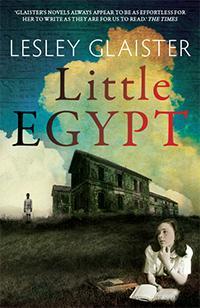
I'm very pleased today to be posting a guest review by Adele Geras, and here it is:
As I sit down to write this review, there's an article in the Times telling us all about mummies. There's an exhibition about them at the British Museum. You would think Egypt was having a 'moment' but in fact, it's always vivid in our imaginations, thanks to the beautiful imagery, the hieroglyphics, the gods and monsters, the scarabs and cats and above all the way they dealt with death. Salt have published LITTLE EGYPT by Lesley Glaister with a beautiful cover which I hope will attract readers who do not know this fine writer. I read her first novel, HONOUR THY FATHER and have been a fan ever since. She's written a dozen novels and one of the big mysteries of the literary world is: why is Glaister not better known? Or more widely read? Or appearing on prize shortlists? She's a supreme describer of that side of life which you could call disturbing or dark but even the most grotesque of her characters comes to life in her pages so that you find yourself understanding and sympathising with even the most damaged/monstrous/demented of them. Have you ever watched those tv programmes about the hoarders next door? The camera swings over the piled-up detritus of their lives, lingering on the dirt and the sheer hugeness of their problems, made real and visible through accumulated junk and we, the viewers, ask ourselves: how can people get into such a state? Where are their families? Where are the social services? Their neighbours? Glaister provides, in this book, reasons for the decline of a huge house called Little Egypt. It's the home of Isis and Osiris, twins in their nineties. Their parents were Egypt fanatics and neglected the children in favour of exploration among the sands and the fruitless search for a never-found tomb. The children were left in the care of Mary and other assorted grown-ups including their damaged Uncle Victor, who never recovered from what he went through in the Great War. There's a double narrative here, and we see things through the eyes of Isis, both in the third person and in the first. This works brilliantly. The first person is reserved for the present-day old woman, wandering the aisles of the supermarket she visits. This is built on land which was once part of the Little Egypt estate but which was sold to developers. She meets an American anarchist called Spike and becomes friendly with him. She loves going to the café and having hot coffee served by Doreen. She likes the light and the noise and above all the order. When we are shown the conditions she's living in, back in the house, this is all too understandable. The central part of the novel goes back to Egypt. Uncle Victor takes the children by ship to look for their parents. Terrible things happen all the time, and Glaister is very good at pointing out the tiny everyday tragedies as well as the huge cataclysmic ones, but she also succeeds in conveying the magic of a country that can enthral otherwise sensible people like Isis and Osiris's parents and lure them away from a life where they'd have to do mundane things like attend to the welfare of their offspring. The third part of the novel I won't even mention, for fear of spoilers. I ought to have been prepared for everything and it still came as a shock. Be warned...you will need a strong stomach to read parts of it, but it's well worth it and it will, I promise you, stay with you for a long time. You won't forget the gallant and warm-hearted Isis and the neglected rooms of the house called Little Egypt will return to you in nightmares. Adele blogs at History Girls (http://the-history-girls.blogspot.com , a joint blog written by authors of historical fiction and fantasy history for Junior (middle Grade), YA and adult readers.